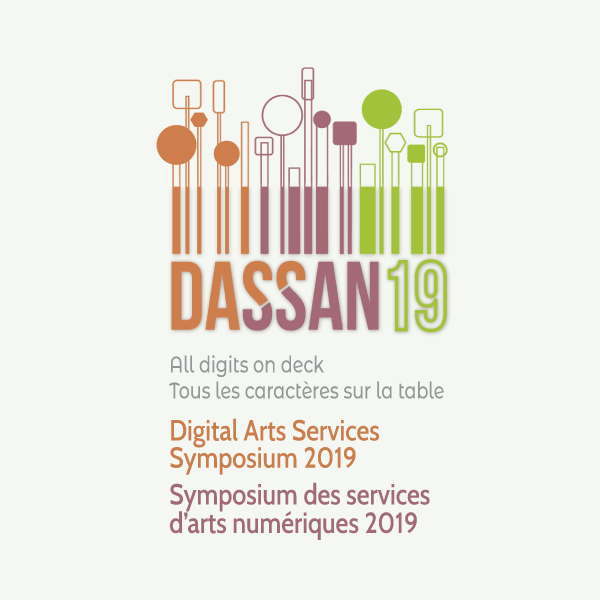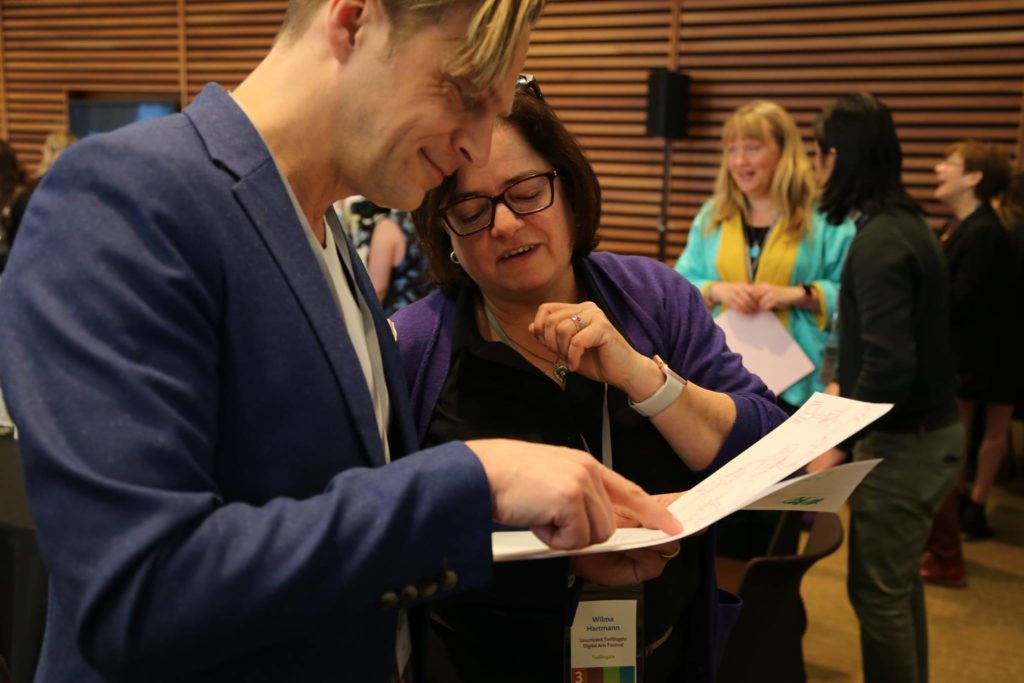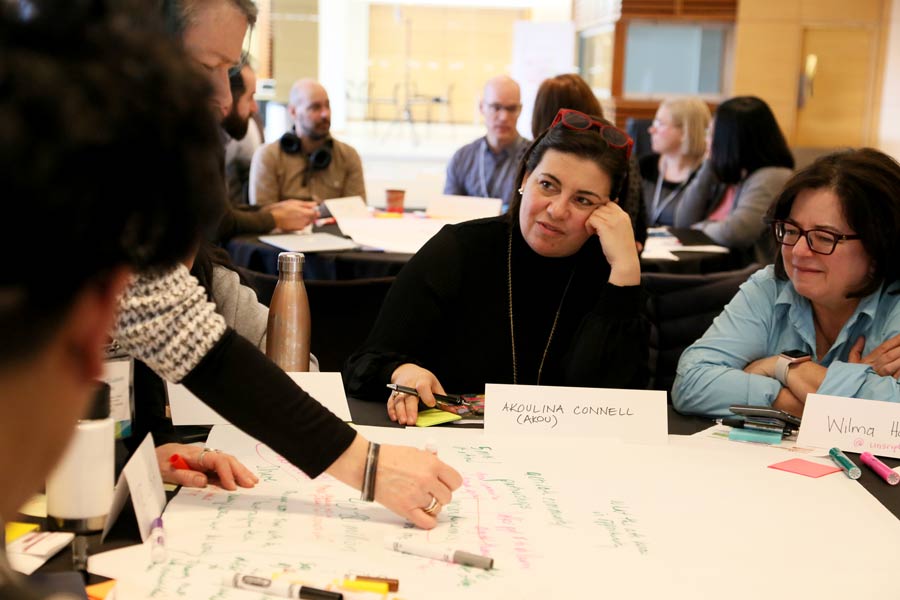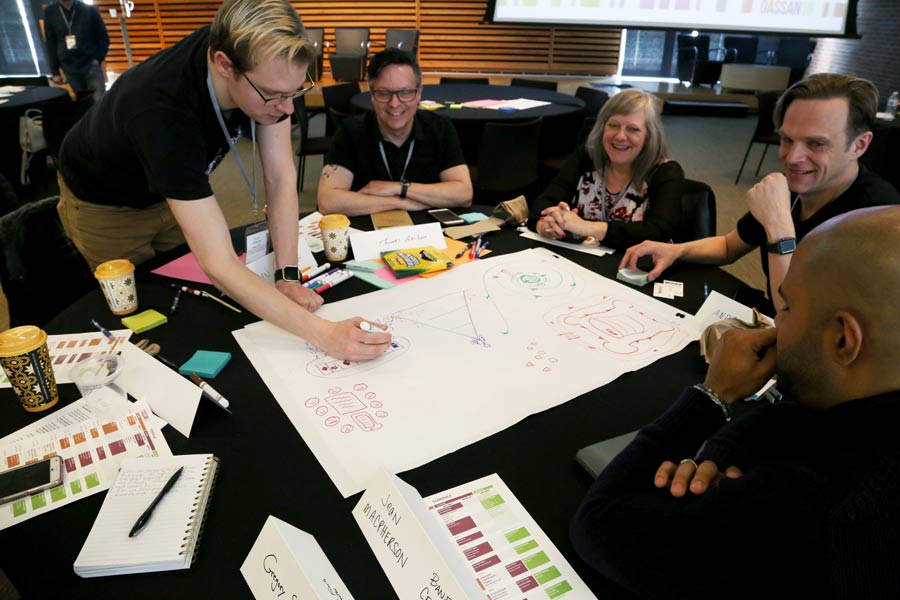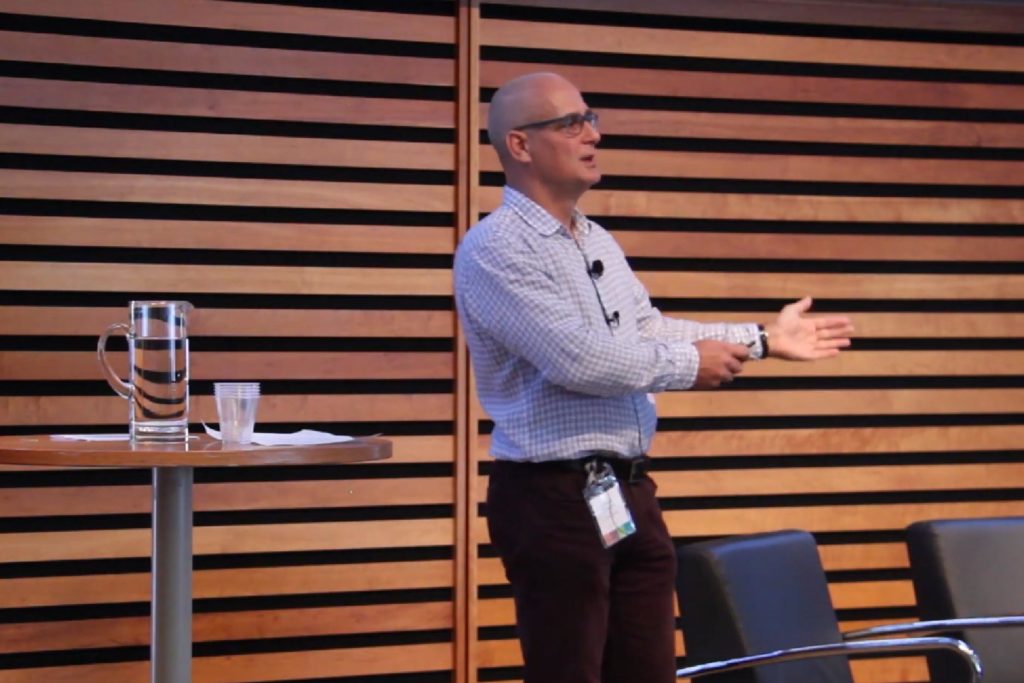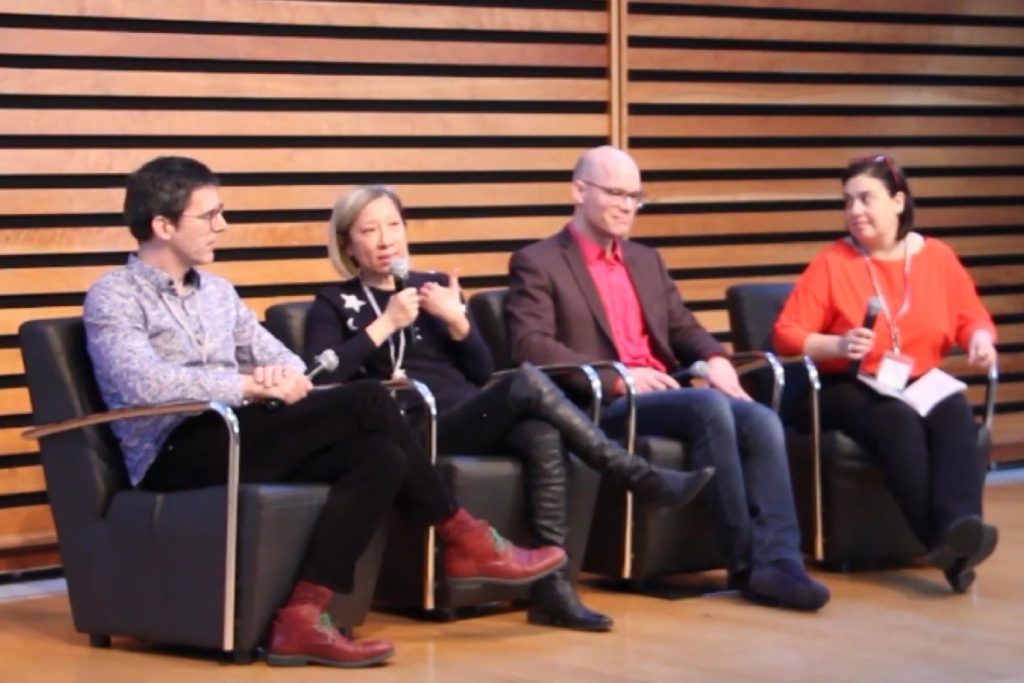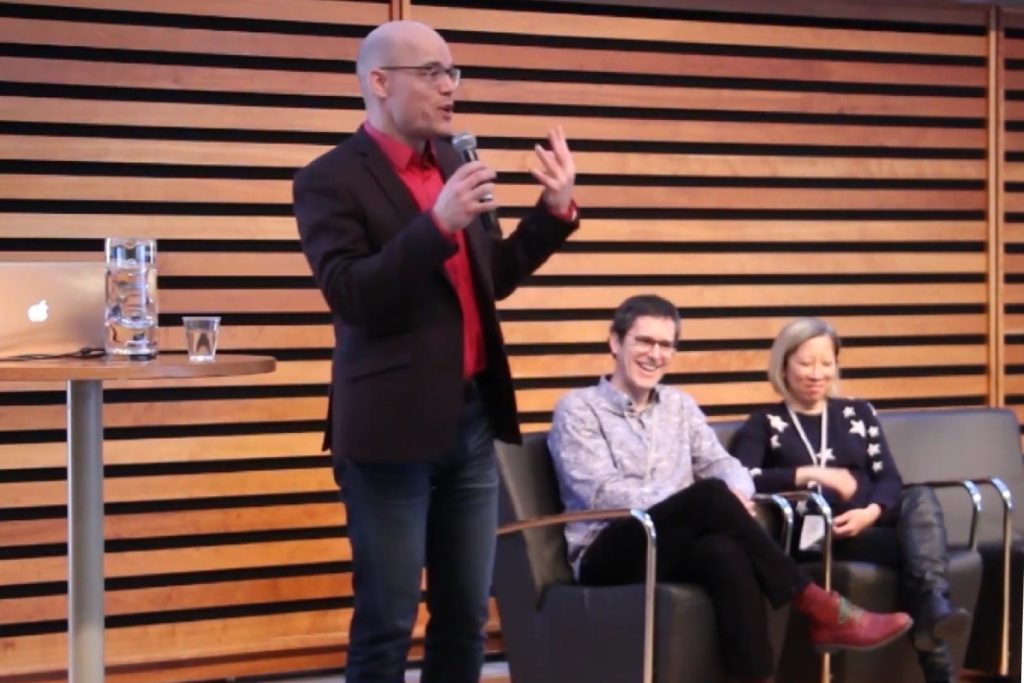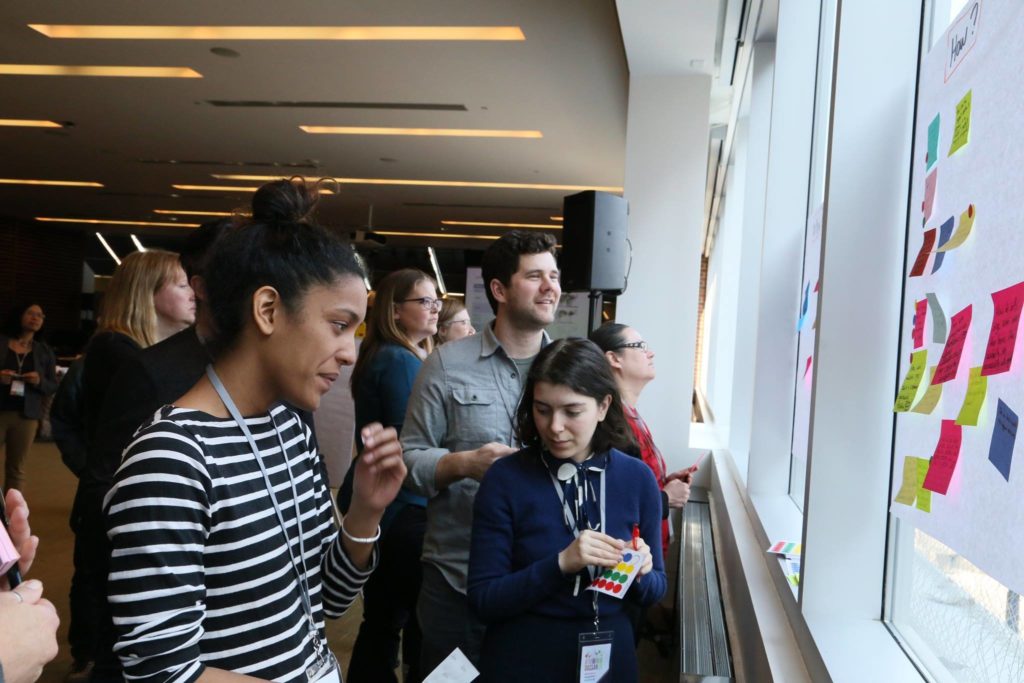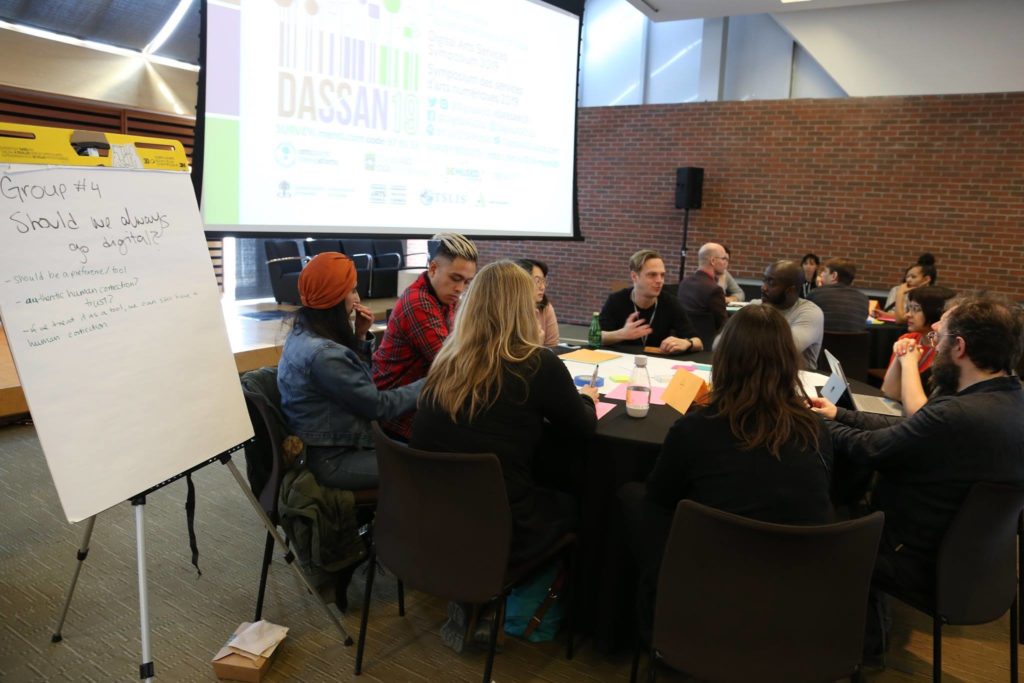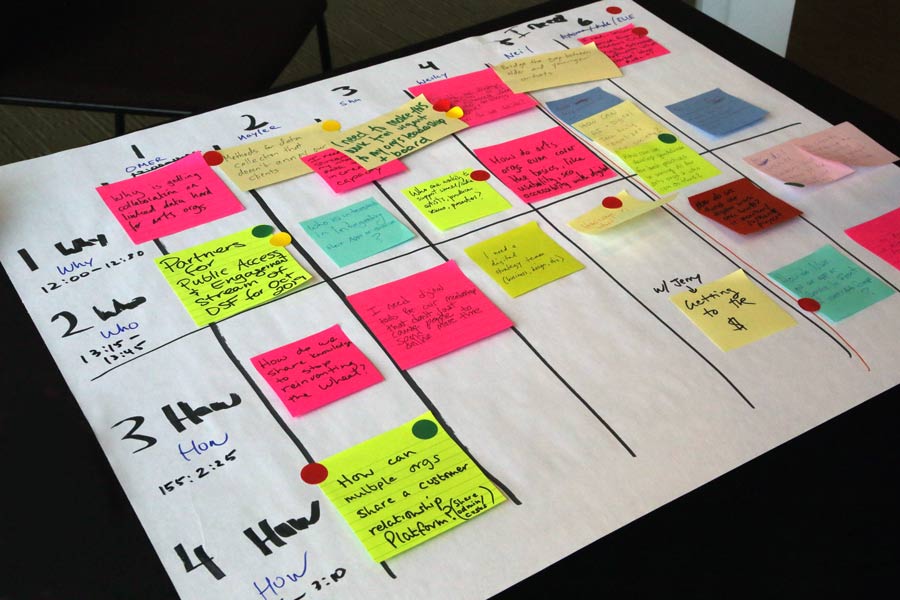All Digits on Deck
Post-conference report by Co-Curators Margaret Lam and Jessa Agilo
Conference guide (2 pages): PDF
Conference program (website): DigitalASO.ca
Archival videos (website): DigitalASO YouTube Channel
The second edition of the Digital Arts Services Symposium 2019 (DASSAN19) was a six-day national digital transformation conference taking place at Toronto’s Artscape Daniels Launchpad, Toronto Reference Library’s Bram & Bluma Appel Salon, and other real and virtual spaces from March 15 to 20, 2019.
DASSAN19 was produced by Executive Producer Jessa Agilo and presented by ArtsPond in association with Agilo Arts, BeMused Network, and Intervene Design. Lead Curators were Jessa Agilo and Margaret Lam, plus Unconference Curator Jerrold McGrath.
DASSAN19 was made possible with generous support of Canada Council for the Arts’ Digital Strategy Fund and strategic funding from Toronto Arts Council’s Open Door.
Major conference themes were:
- Prologue: Who is out there? (March 15-17)
- Inspirational Stories: Where have we been? (March 18)
- Critical Reflection: Where are we going? (March 19)
- Practical Transformation [Unconference]: How do we get there? (March 20)
DASSAN19 featured five free Prologue activities, including three social and networking events onsite and two educational webinars online. The main conference from March 18 to 20, 2019 featured 50 speakers and facilitators from Canada, United States, Australia and United Kingdom and included 32 presentations, workshops, panel discussions and other educational and networking events.
Major conference topics included:
- Managing growth in face of rapid digital transformation
- Policy innovations in ethics and governance of AI for social good
- Digital literacy and culture for youth and children
- Design thinking tools
- Fostering digital strategy alliances
- BIPOC and disability arts perspectives
- Discoverability and linked open data
- Data analytics
- VR/AR, blockchain and other emerging media
- Platform cooperatives
- Pitch sessions and networking events
Keynote speakers included:
- Ana Serrano (Canadian Film Centre) [YouTube]
- Valentine Goddard (AI Impact Alliance)
- Cimeon Ellerton (The Audience Agency) [YouTube]
- Michael Chappell (Culture Counts) [YouTube]
- Frédéric Julien (CAPACOA) [YouTube]
- Tammy Lee and Gregory Saumier-Finch (Culture Creates) [YouTube]
Featured speakers included:
- Ariane Couture (Alliance Culture + Numérique)
- Camille Georgeson-Usher (Aboriginal Curatorial Collective) [YouTube]
- Zannie Giraud Voss (SMU DataArts)
- Sara Grimes (University of Toronto)
- Aaron Labbé (The Lucid Project)
- Michael Prosserman (EPIC Leadership Support)
- Dr. Olivier St Cyr (University of Toronto)
- Margaret Vincent (Stocksy United)
- Sagan Yee (Hand Eye Society) [YouTube]
- Helen Yung (Culture of Cities) [YouTube]
Additional panelists, speakers, and facilitators included:
- Sha Abgayani (Rootcare)
- Akoulina Connell (Consultant)
- elle alconel (Independent)
- Sue Biely (Digital Ladders / BC Alliance for Arts + Culture)
- Evond Blake / MEDIAH (IAH DIGITAL)
- Padina Bondar (Designer)
- Wesley Cabarios (MVDHOUSE)
- Mila Dechef-Tweddle (Nordicity)
- Carly Frey (Nordicity West)
- Heran Genene (Digital Knomads)
- Priam Givord (Interactive Designer)
- Candice Houtekier (Digital Content Manager)
- Richard Lachman (Ryerson University)
- Magdalena Lagerlund (Museum London)
- Peter Lyman (Nordicity)
- Carla Pereira (Peel District School Board)
- Tyreek Phillips (Creative Director)
- Stephen Sawyer (Prescient Innovations)
- Andrew Scholotiuk (Film Reel / FAVA)
- Giorgia Severini (Writers’ Guild of Alberta)
- Anju Singh (DiverseTheatreBC / Visceral Visions)
- Maylee Todd (Artist)
- Neil Watson (MVDHOUSE)
- Daniel Webster (ART2U, Greenland Productions)
- Tim Whalley (Prologue to the Performing Arts)
- Michael Wheeler (foldA, SpiderWebShow Performance)
Impacts and Outcomes
Each of the key objectives for DASSAN19 were met, including inciting greater digital strategy collaborations across disciplinary silos, strengthening digital literacy of artists and arts professionals, and positioning Canada as a leader in the emergence of digital arts services.
For example, in post-conference surveys, 80% of respondents either agreed or strongly agreed that DASSAN19 was valuable to them and 81% learned something new by attending DASSAN19. 81% were satisfied or strongly satisfied with keynote speakers and panelists and 79% with the unconference overall. When asked whether they would attend a future edition, none of the delegates said no, 46% said yes, and 54% said maybe. Interest in using DASSAN as a vehicle to sustain national conversation was high with 71% of respondents wanting the next edition of DASSAN to take place within 12 to 18 months, 21% within 24 to 36 months, and only 8% no preference.
Additionally, a collaborative proposal to establish a national, cross-disciplinary Digital Arts Services Alliance / Alliance des services d’arts numerique has also stemmed directly from DASSAN19, which is led by ArtsPond and includes supporters from across Canada and internationally.
While net registration revenues were 75% lower than originally projected (and resulted in budgetary changes and reductions), DASSAN19 attracted a diverse national audience including 150 participants representing 9 of 13 provinces and territories. 41 artists and other low-income groups also received $13,783 in bursaries and scholarships to strengthen access. Regrettably, a planned Hackathon competition was cancelled due to a lack of interest.
Highlights
No technology is value-neutral. The private sector has been the main driving force behind our increasingly digital society, and we are at the beginning of a seismic shift much like the creation of the world wide web almost three decades ago. The question today is not how the public sector will contribute to the change, but rather how it will take a lead in shaping the technologies that will define our society for future generations.
Both Ana Serrano and Valentine Goddard’s keynote brought this idea into sharp relief. In the public, the power of individuals to coordinate mass action to amplify their collective voices and speak truth to power is growing. Behind the scenes, the rapid development of Artificial Intelligence is driven primarily by private interests, with profound implications to all aspects of our lives.
Meanwhile, grappling with the complexities of shared intelligence and discoverability of arts data in hyper-local and global markets was unwrapped by an international cast of speakers including keynotes by Cimeon Ellerton (UK), Micheal Chappell (Australia), Frédéric Julien, Tammy Lee and Gregory Saumier-Finch (Canada), and featured speaker Zannie Giraud-Voss (United States).
Closer to the ground, DASSAN19 also shared compelling examples of how organizations have structured themselves in novel ways, in order to create digital solutions that serves the needs of a community. Stocksy United’s platform co-op offers a way for photographers to get compensated directly from sales of their stock images. FAVA’s Film Reel / AMSNetwork has grown systemically over a decade to address the needs of film and video artists through a partnership model with regionally-based artist collectives. Alliance Culture + Numérique also illustrated an inspiring case of how to practically align diverse, cross-sectoral teams to pursue and sustain collaborative digital transformation initiatives and strategies in an open and flexible structure.
What became clear is that there have been efforts across Canada and abroad long before public funders launched strategic funding for digital initiatives. Experimenting with technology, pushing ourselves to explore uncharted domains, have been happening in isolation. What is needed more than ever is for these initiatives to align in order to share resources, knowledge, and ultimately identify a sector-wide agenda for digital transformation.
Unconference
The Unconference on the final day of DASSAN19 was structured as open, participant-led dialogue. With a theme of “A Beautiful Life, A Thriving Future”, the Unconference asked delegates to collectively identify topics of interest to be discussed in small, breakout groups across four sessions of 45-minutes each. Potential topics identified by delegates included:
- Digital leadership 101 – what should we have in place?
- Decision to develop arts-owned data “pool” that’s owned and accessed by the sector
- Mapping services/product development stages and purposes, how they align
- Common language for own sector, not adopt only from technology/business
- Canada Council funding, how to navigate as funding seekers
- Organizational culture or ethos: open collaboration vs typical business models
- Ethical accountability in own projects
- Tackle Digital Divide, equality of access
- Indigenous and non-western ideas about digital literacy
- How do we elevate each other and amplify each other’s work?
- What does a digital literacy curricula / training look like?
- How to work with what access to tech / digital we have?
- Lessons from film/tv sector’s digital shift?
- The granularity, focus, scope, regions, stakeholders, etc
- Drivers/innovators in the sector, barriers to more forward, support leaders and edge-walkers
- Advocacy for digital initiatives
- Work out common language with key sectors like research, design, etc
Participant Feedback
- “I wish every day was DASSAN19!”
- “Thank you for a great horizon-expanding event!”
- “The tremendous work you put into the symposium definitely showed. It was great to be able to be in a room with other organizations exploring similar shifts and to confirm we are on the right track. And thank you for the bursary – it enabled me to attend this year.”
Why did delegates attend DASSAN19?
In a post-conference survey, the main reasons identified by participants included “learning”, “digital strategy”, “networking”, and “other”:
Learning
- “To network with other organizations and take-home knowledge on how to best use the digital landscape at my organization.”
- “To hear keynote speakers and see what is happening elsewhere in Canada.”
- “I wanted to find out more about the digital arts space, its current issues, and discourse. I also wanted to meet other like-minded people.”
- “To hear what people are saying and thinking about.”
- “Digital arts are directly applicable to what I do. I wanted to learn more about what technologies were out there, who is doing the work, and innovation in the sector.”
- “My organization has tried (and failed) at getting CCA Digital Strategy Funding in the past and I wanted to learn more about what other organizations are doing differently and how to improve our chances for the next round.”
- “To engage in sector-wide discussions about shifting our thinking on digital technology, to meet people from across the country with similar intentions, to learn about some ideas already in the works.”
- “I feel I need to learn more about digital strategies for my organization.”
- “I have a lot to learn and this is an educational opportunity for me.”
- “Thought that I would learn about more tools available to ASOs, however it was not challenging enough for me.”
- “To learn from others.”
Digital Strategy
- “To get the most current updates about digital tools and strategies that specifically relate to arts organizations.”
- “To get a sense of how other organizations are incorporating digital strategy and projects in their work.”
- “The topic is relevant and timely to our organization and upcoming project plans.”
- “Looking at developing a digital strategy, new contacts, and meeting new arts service organizations that might be interested in partnering.”
- “To obtain an understanding of Digital Strategy.”
Networking
- “Discover what’s happening in the sector.”
- “Build a network with digital arts organizations and artists.”
- “For networking with potential collaborators in the digital transformation of the arts sector.”
Other
- “Totally relevant for arts services organizations.”
- “My manager and I thought it sounded interesting and relevant to the work we’re doing, so we decided to check it out.”
- “Word of mouth recommendations.”
- “I’m an immersive digital theatre artist and was invited by a colleague to attend and bring knowledge back to Saskatchewan. I also looked forward to connecting to other immersive theatre artists and AR developers.”
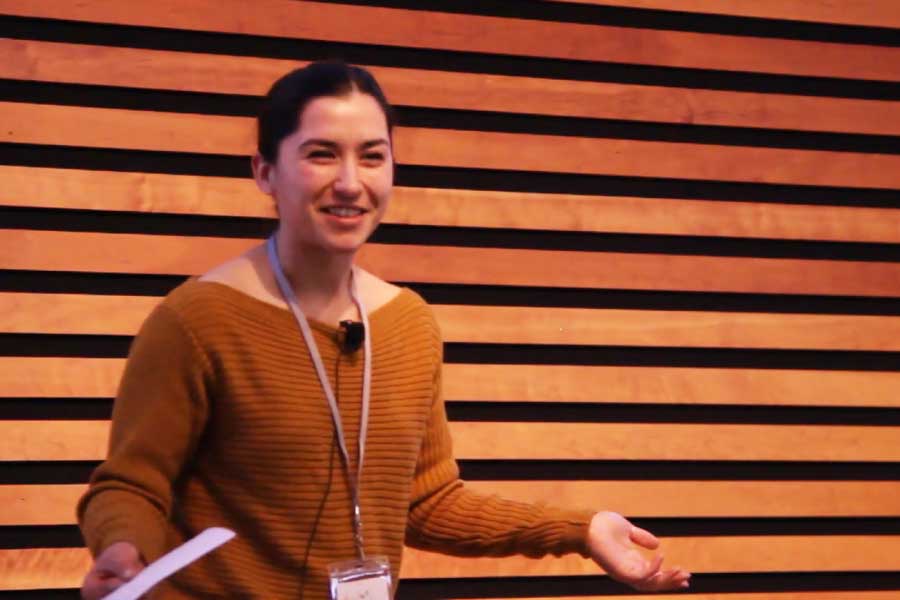
What were delegates favourite memories of DASSAN19?
Favourite memories identified by participants included the unconference, networking, opening and closing plenaries, keynote speakers, and other presentations:
Unconference
- “The unconference format and topics.”
- “The Unconference. I learned a lot in casual but respectful and thoughtful sessions.”
- “Explaining my digital journey to strangers and interpreting theirs.”
- “The drawing of maps and explaining them on day one was cute – I enjoyed that more than I thought I would.”
- “There were many, but I especially enjoyed the unconference discussions.”
- “I was able to listen to some great conversations in the last two sessions of the unconference – also great and smart moderation by the UKAI Projects facilitators.”
- “Reflections [during the] unconference.”
- “The unconference table topics.”
Networking + space
- “Networking.”
- “Meeting new people.”
- “Meeting diverse and very interesting people.”
- “Networking, having discussions with other delegates, meeting diverse and very interesting people.”
- “Discussions between attendees in general were excellent – so many interesting people doing so much interesting work and all willing to share.”
- “I liked the space and the atmosphere.”
Opening + closing plenaries
- “Sagan Yee’s opening plenary talk was strong.”
- “Sagan Yee’s ‘open letter’ to the framers of the Digital Strategy Fund”
- “Helen Yung’s opening plenary talk was amazing!”
- “The wrap-up discussions (Zones A, B, and C) at the closing plenaries.”
- “The design of ‘Let’s Play’ sessions.”
Keynote speakers
- “Ana Serrano’s Keynote (Data Justice)”
- “Valentine Goddard’s talk (AI Ethics Keynote).”
- “The ‘a-ha’ moment when people started to really understand metadata (Linked Open Data Keynote).”
- “The panel with Frederic Julien, Tammy Lee and Gregory Saumier-Finch (Linked Open Data).”
Other presentations
- “[T]he ‘Small Wonders’ VR experience (Priam Givord).”
- “The virtual reality demonstration (Pram Givord).”
- “Anju Singh Christofferson pitch presentation (Diverse Theatre BC).”
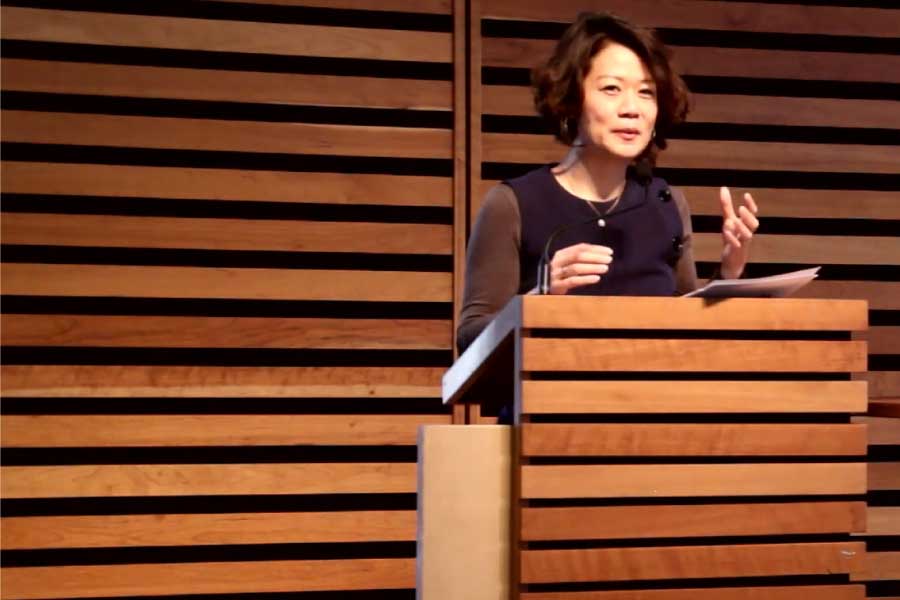
What did delegates find challenging about DASSAN19?
Participants identified the unconference, lack of knowledge and networks, and conference structure as the most challenging:
Unconference
- “I was apprehensive about the structure of the unconference at first but it was great!”
- “As mentioned by the facilitator, ‘this is the part where the introverts in the audience get uncomfortable’. And while forced social activities are usually anxiety-inducing for me, the roundtable activities that we did were actually great after I knew what to expect.”
- “The unconference had some generative moments but perhaps lacked a bit of closure… or maybe that’s just the nature of unconferences. Not sure.”
- “(Making) drawings (during the unconference)!”
- “When we had to decide on discussion topics – for me it was a requirement to be sporadic rather than drill down on my own narrative (and the importance or validation of my own narrative).”
Knowledge + networks
- “Understanding the language of digital literacy, keeping up with the topics being discussed that I am not as familiar with (AI, blockchain and data management, digital transformation).“
- “Some of the discussion struggled to move beyond the difficulties of the question (but all were handled in a friendly and supportive manner, I thought.”
- “Contributing to discussions at the conference when I don’t have an administrative/business background and often felt out of the loop.”
- “I was a bit disappointed not to find a much broader range of ideas.”
- “Not knowing anybody or anything about the specifics of this area when I first arrived.”
- “Not knowing who was in the room during the day.”
- “I am shy and find it hard to start up conversations with people I don’t know.”
- “Making friends.”
Structure
- “The breaks were weirdly spaced – more time asking the audience questions to the panelists would have been useful.”
- “Three days was long. Two days would have been great.”
- “Group activities didn’t seem all that productive.”
- “The lack of critical discourse on the contradictions between the colonialist, materialist capitalist tech industry and spiritual Indigenous arts culture — and the socially revolutionary nature of arts in general.”
- “Too many participatory experiences.”
- “Realizing that there was all this funding to do digital transformation, but not necessarily to sustain the work, once built.”
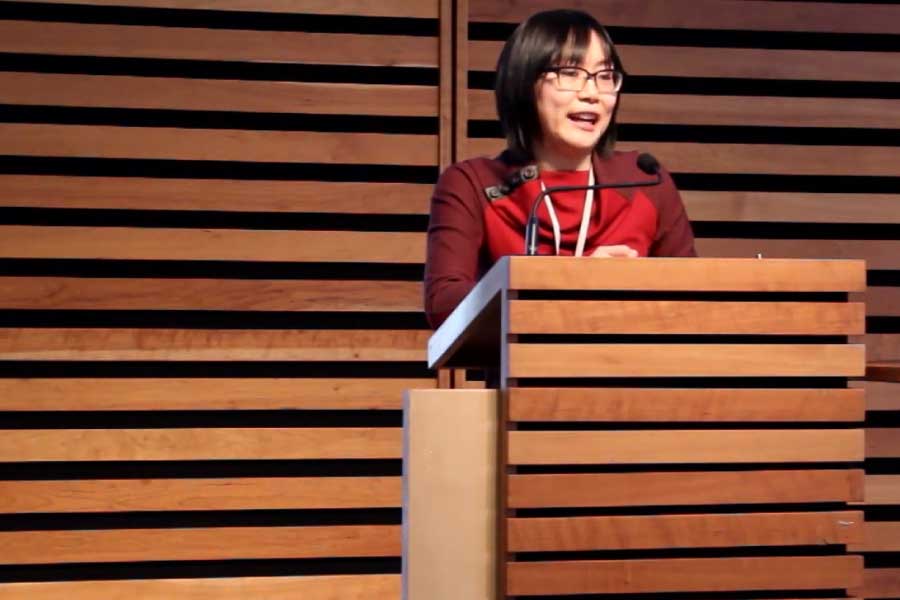
Is there anything delegates would have liked to have seen done differently next time?
Some delegates identified components of structure, diversity, and intelligence as desired changes for future editions of the symposium, while others couldn’t see the need for changes:
Structure
- “Have more occasions to network during sessions (breaks quick because of delay in schedule)”
- “I think pre submission of digital strategy challenges and possible solutions, to help delegates to determine “fit” and overlaps (raising the potential for collaborative relations to be formed during the conference) rather than hearing everyone out during the conference to determine good fits only at the end. Interesting and vital processes none the less going in blind.”
- “More time for participants to introduce themselves.”
- “More key notes, less group activities.”
- “I guess I’m accustomed to having vendors at conferences, and I was hoping that I might have the chance to talk with industry folks about various products and services. However, it didn’t take away from the experience for me at all.”
- “It’s unfortunate that the dinners weren’t better attended – perhaps a less structured meetup might have worked better, like at a lounge or pub instead of a restaurant?”
Diversity
- “More diversity among presenters.”
- “More funders in the house, and more presence of large arts organizations.”
- “The trick I think would have been to get a more dynamic contingent of leaders or up-and-comers into the room. Jerrold McGrath did his level best to set a more diverse tone with the facilitators and provokers he recruited for the unconference, but this didn’t really translate over to the audience who showed up. It felt to me like many attendees were relative novices who defaulted into a strictly “spectator” role, which only reinforced the spectacle dynamic that infuses this whole digital situation: the divide between active and passive, between the already-initiated and those looking in from outside.”
Intelligence
- “More critical discussion about capitalism and data justice. We cannot digitize arts orgs without unpacking this — it is arguably the most important thing in this whole discourse.”
- “I would like to have more solutions presented in the presentations and panels. I felt many of the topics were future-facing and didn’t offer any insights on what I can do ‘now*’ to improve the digital presence of my organization.”
No changes
- “Not off the top of my head – the range of speakers was great and the schedule/pacing was excellent. I appreciated the frequent breaks to balance information overload.”
- Categories:Knowledge building, Ecosystem building
- Project URL:https://digitalaso.ca/dassan19-schedule/
- Dates:Mar 15 to 20, 2019

